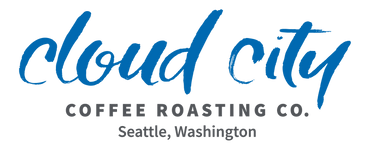Agtron Roast Value or How Do We Decide What is Light, Medium, or Dark
Roasters regularly give their customers clues to the type of coffee found in their bags. Flavor notes, origin, and altitude are some of these- but the roast degree, or how lightly or darkly a coffee is roasted, is probably the most valued piece of information.
We have a lot of customers who automatically say dark is their favorite when questioned, and in Seattle that is not surprising. Many palates were trained by Starbucks. My old café El Diablo Coffee (RIP) specialized in dark roast because it worked best for Cuban coffee, so we have a soft spot for it as well (and as such will always carry the El Diablo Blend).
However, people mostly buy the medium roast, the Cloud City Blend. Medium roasts are roasted right up the point where you can taste maximum sweetness and before the bitterness of a dark roast takes over.
Because we sell so much of this coffee, it is important to roast it exactly the same week after week. Consider that the blend changes throughout the year to reflect fresh crop coffees, and it becomes more complicated. To hit that roast degree consistently, we have one important tool in our arsenal: the Agtron spectrophotometer, which analyzes the roast value.

This unassuming but pricey little device measures how light or dark a coffee is by measuring the wavelengths of what is soluble in a cup of coffee. There are other methods of measuring the roast value of coffee, but we use this one because it has a long history of usage in the coffee community. These wavelength values are assigned numbers and we can aim for a specific number to ensure consistency between roasts.
For example, the Cloud City Blend measures a 63.9 Agtron and we aim to be within one number higher or lower to ensure we create the same product each time. And of course, this only applies to the current blend as the blend changes throughout the year and the Agtron goal changes with it. Agtron’s scale ranges between 25 and 95, with the darker coffees corresponding to the lower numbers.
You can either measure whole bean or ground coffee, and we opt for ground. We have steadily ground it a bit finer to present more surface area for the analyzer. Here is a photo of a the ground coffee prepared to be analyzed.



Photo depicts Light roast of Ethiopia Lecho Torka.
Higher numbers equate to lighter roasts.
We operate within a much closer range than that, but generally as follows:
*Our darkest roast, El Diablo Blend, is a 55.9 Agtron. This is just past second crack and the darkest we will go.
*Our espresso, The Mountain’s out, is a 62 Agtron, developed enough for great body under 9 bars of pressure, but in the sweet spot for caramelization.
*Our light roasts vary. A lower altitude, less dense bean tends to be a 70-71 Agtron, while high grown, dense coffees taste great at an 80-85.
Based on these examples, you can see our range is
Light: Agtron 70-85
Medium: Agtron 60-69
Dark: Agtron 50-59
We blend and roast to taste, and the Agtron follows. For the dark blend, we knew we wanted a tasty dark roast, so we loaded it with a highly acidic Honduran coffee (45% of it is Honduran). Roasting darkly reduces acidity so we wanted to give this coffee a shot at having decent acidity. Acidity is also the component that fades the most when adding cream and it important in making the coffee taste, well, like coffee when adding cream.
We roast highly grown, flavorful coffees lighter so you can taste the terroir as opposed to the roast. Using the Agtron helps to ensure we don’t over roast these delicate coffees. We hope you enjoy.




